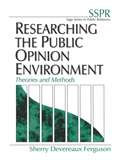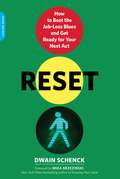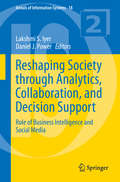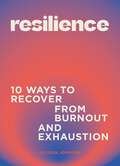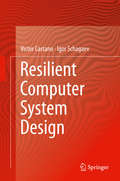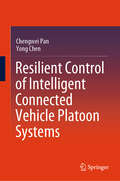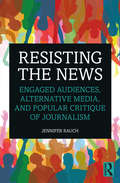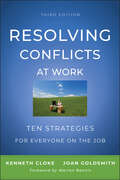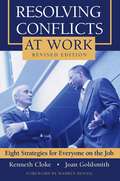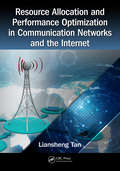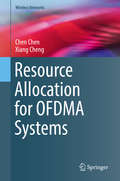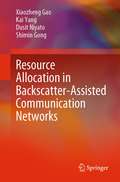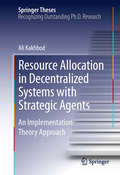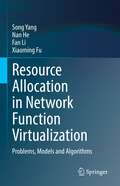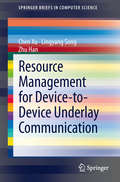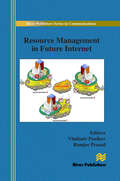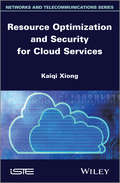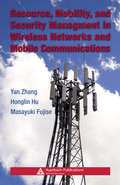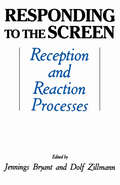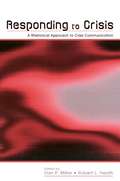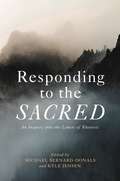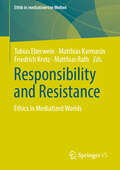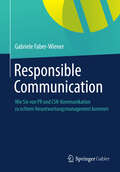- Table View
- List View
Researching the Public Opinion Environment: Theories and Methods
by Sherry Devereaux FergusonResearching the Public Opinion Environment: Theories and Methods informs the reader on the rationale, purposes, theories, and methodologies involved in researching the public. The book is divided into four parts. Part One looks at the theories and systems relevant to opinion research. Part Two addresses the topics of monitoring and analyzing the media. Part Three describes the basics of survey research, focus groups, Delphi techniques, stakeholder assemblies and Q methodology. Part Four analyzes the impact of the media.
Reset: How to Beat the Job-Loss Blues and Get Ready for Your Next Act
by Dwain SchenckWelcome to the new world of job insecurity. Layoff. If you haven't experienced one, you know someone who has. Dwain Schenck speaks with authority; not only has he seen energetic, talented, and accomplished friends undergo the stress of job loss, but he, too, has felt the sting of being "let go." Reset is the uncompromising portrait of Schenck's journey: a successful journalist and communications professional who joins the ranks of the unemployed during the most dismal job market in modern history, his initial reactions of denial and depression sabotage his morale and motivation. Then, with the assistance of friends, wisdom from experts, and good old-fashioned creativity and tenacity, Schenck turns his attitude around. The hard-won, valuable advice and techniques in these pages can work for anyone concerned about job loss or keeping a job. Reset can position you to get back on your feet, often landing in a better place. Schenck covers a wide variety of topics with a humorous, light touch that balances the serious subjects within, which include: The Emotional Phases of Unemployment Who Am I? Insecurity and Uncertainty Rules for Effective Networking Knowing Your Value in a Buyer's Market The Social Life of the Unemployed Mastering the Art of Reinvention With insight and inspiration from Mika Brzezinski, Donald Trump, Christine Hefner, Mort Zuckerman, Susie Essman, Donny Deutsch, Larry David, Joe Echevarria, Mike Barnicle, and Joe Scarborough
Reshaping Society through Analytics, Collaboration, and Decision Support
by Daniel J. Power Lakshmi S. IyerThis volume explores emerging research and pedagogy in analytics, collaboration, and decision support with an emphasis on business intelligence and social media. In general, the chapters help understand where technology involvement in human decisions is headed. Reading the chapters can help understand the opportunities and threats associated with the use of information technology in decision making. Computing and information technologies are reshaping our global society, but they can potentially reshape it in negative as well as positive ways. Analytics, collaboration and computerized decision support are powerful decision aiding and decision making tools that have enormous potential to impact crisis decision making, regulation of financial systems, healthcare decision making and many more important decision domains. Many information technologies can potentially support, assist and even decide for human decision makers. Despite the potential, some researchers think that we know the answers to how these technologies will change society. The "Wisdom of Crowds" or "Big Data" become the topic of the day and are soon replaced with new marketing terms. In many ways, mobile technology is just another form factor to adapt decision support capabilities too and experiment with new capabilities. The cloud is a nebulous metaphor that adds to the mystery of information technology. Wireless technology enables the ubiquitous presence of analytics and decision support. With new networking capabilities, collaboration is possible anywhere and everywhere using voice, video and text. Documents can be widely shared and massive numbers of documents can be carried on a small tablet computer. Recent developments in technologies impact the processes organizations use to make decisions. In addition, academics are looking for ways to enhance their pedagogy to train students to be more adept in understanding how emerging technology will be used effectively for decision making in organizations. The chapters are based on papers originally reviewed at the Special Interest Group on Decision Support Systems (SIGDSS) Workshop at the 2013 International Conference on Information Systems (ICIS 2013). Ultimately this volume endeavors to find a balance between systematizing what we know, so we can teach our findings from prior research better, and stimulating excitement to move the field in new directions.
Resilience: 10 ways to recover from burnout and exhaustion
by Jolinda JohnsonStress is inevitable.Burnout is optional.Resilience is possible.Are you ready to live more peacefully?Stress will always be a part of life, but your response to it can improve dramatically. Through quick, constructive exercises, inspirational quotes, journaling activities and reflective practices, this ten-step programme can build your resilience and change your life.
Resilience: 10 ways to recover from burnout and exhaustion
by Jolinda JohnsonStress is inevitable.Burnout is optional.Resilience is possible.Are you ready to live more peacefully?Stress will always be a part of life, but your response to it can improve dramatically. Through quick, constructive exercises, inspirational quotes, journaling activities and reflective practices, this ten-step programme can build your resilience and change your life.
Resilient Computer System Design
by Igor Schagaev Victor CastanoThis book presents a paradigm for designing new generation resilient and evolving computer systems, including their key concepts, elements of supportive theory, methods of analysis and synthesis of ICT with new properties of evolving functioning, as well as implementation schemes and their prototyping. The book explains why new ICT applications require a complete redesign of computer systems to address challenges of extreme reliability, high performance, and power efficiency. The authors present a comprehensive treatment for designing the next generation of computers, especially addressing safety critical, autonomous, real time, military, banking, and wearable health care systems.
Resilient Control of Intelligent Connected Vehicle Platoon Systems
by Yong Chen Chengwei PanThe book focuses on the design of resilient control schemes for intelligent connected vehicle platoon systems. The issues of physical faults, malicious cyber-attacks and external disturbances are studied from the perspective of resilient control. The contents of this book introduce a variety of control schemes in detail, and give simulation or experimental verification cases. To enable readers to learn the resilient control methods of vehicle platoon systems is the main benefit of this book. Meanwhile, this book also benefits researchers, engineers, graduate students in related fields such as nonlinear control, robust control, resilient control, vehicle platoon control, etc.
Resisting the News: Engaged Audiences, Alternative Media, and Popular Critique of Journalism
by Jennifer RauchResisting the News brings together unique insights from activists and alternative-media users to offer a distinctive perspective on the problems of journalism today—and how to fix them. Using critical-cultural theory and, in particular, the conceptual frameworks of ritual communication and interpretive communities, this book examines how audiences filter their interpretations of mainstream news through the prisms of their identities and experiences with alternative media and political protest. Jennifer Rauch gives voice to alternative-media audiences and illuminates the cultural resources, values, assumptions, critical skills, and discursive strategies through which they make sense of their news environments. Drawing on a 15-year research project, Rauch employs a variety of qualitative, quantitative, and quasi-ethnographic methods, including focus groups, media-use diaries, close-ended surveys, and open-ended questions, to paint a layered portrait of liberal and conservative critiques of journalism. Shedding new light on popular theories about "how news works" and about "mass" audiences, this book will be useful to students, scholars, and teachers of political communication, journalism studies, media studies, and critical-cultural studies.
Resolving Conflicts at Work
by Joan Goldsmith Kenneth ClokeThe classic text on resolving workplace conflicts, fully revised and updatedResolving Conflicts at Work is a guide for preventing and resolving conflicts, miscommunications, and misunderstandings at work, including dozens of techniques for revealing how the inevitable disputes and divisions in the workplace are actually opportunities for greater creativity, productivity, enhanced morale, and personal growth. In the third edition of this text, all chapters are completely infused with additional content, updated examples, and new case studies. Like its predecessors, it identifies core strategies for preventing and resolving both intermittent and chronic conflicts in the workplace. In addition, the bookIncludes a new foreword by Warren Bennis, which represents his most recent thinking about judgment calls and candid communications in the workplacePresents new chapters on leadership and transformational conflict coaching, and organizational systems designThis definitive and comprehensive work provides a handy guide for managers, employees, union representatives, human resource experts, and consultants seeking to maintain stable and productive workplaces.
Resolving Conflicts at Work
by Warren Bennis Joan Goldsmith Kenneth ClokeHere is a completely updated edition of the best-selling Resolving Conflicts at Work. This definitive and comprehensive work provides a handy guide for resolving conflicts, miscommunications, and misunderstandings at work and outlines the authors' eight strategies that show how the inevitable disputes and divisions in the workplace actually provide an opportunity for greater creativity, productivity, enhanced morale, and personal growth. This new edition includes current case studies that put the focus on leadership, management, and how organizations can design systems to change a culture of avoidance into a culture of creative conflict. The result is a more practical book for today's companies and the people who work in them.
Resource Allocation and Performance Optimization in Communication Networks and the Internet
by Liansheng TanThis book provides a comprehensive introduction to the underlying theory, design techniques and analytical results of wireless communication networks, focusing on the core principles of wireless network design. It elaborates the network utility maximization (NUM) theory with applications in resource allocation of wireless networks, with a central aim of design and the QoS guarantee. <P><P> It presents and discusses state-of-the-art developments in resource allocation and performance optimization in wireless communication networks. It provides an overview of the general background including the basic wireless communication networks and the relevant protocols, architectures, methods and algorithms.
Resource Allocation for OFDMA Systems (Wireless Networks)
by Xiang Cheng Chen ChenThis book introduces the sources and historic collection campaigns of resource allocation in wireless communication systems. The unique characteristics of MIMO-OFDMA systems are thoroughly studied and summarized. Remarks on resource allocation and spectrum sharing are also presented, which demonstrate the great value of resource allocation techniques, but also introduce distinct challenges of resource allocation in MIMO-OFDMA systems. Novel resource allocation techniques for OFDMA Systems are surveyed from various applications (e.g., for unicast, or multicast with Guaranteed BER and Rate, subcarrier and power allocation with various detectors, low-complexity energyefficient resource allocation, etc.) in this book.Due to the high mobility and low latency requirements of 5G wireless communications, this book discusses how to deal with the imperfect CSI. It also discusses how to deal with e.g., throughput maximization, outage probabilities maximization and guarantee, energy efficiency, physical-layer security issues with feedback channel capacity constraints, in order to characterize and understand the applications of practical scenes.This book will target professionals & researchers working in the fields of Wireless Communications and Networking, Resource Allocation and Transmissions. Advanced-level students in electrical engineering and computer science will also find this book useful as a secondary textbook.
Resource Allocation in Backscatter-Assisted Communication Networks
by Dusit Niyato Kai Yang Xiaozheng Gao Shimin GongThis book investigates the resource allocation in backscatter-assisted communication networks. With the development of backscatter communications, integrating backscatter communication technology into traditional communication networks can improve the network performance significantly. To fully improve the performance of backscatter-assisted communication networks, resource allocation is of special importance. It is worth to mention that the resource allocation in backscatter-assisted communication networks is more challenging than that in traditional communication networks, and the tradeoff of the performance between backscatter communications and traditional communications needs to be carefully considered. In this book, considering that game theory is an attractive tool for developing and analyzing distributed, flexible, and autonomous networks, we develop the auction-based time scheduling schemes, contract-based time assignment scheme, and evolutionary game-based access point and service selection scheme for the backscatter-assisted radio-frequency-powered cognitive networks, where some important properties such as individual rationality are considered. We also employ the optimization approach and develop a relay mode selection and resource sharing scheme for backscatter-assisted hybrid relay networks to improve the throughput. We believe that the developed resource allocation schemes in this book can provide useful guidance for the design of backscatter-assisted communication networks and future Internet of Things. Graduate students, researchers, and engineers in the field of communication networks can benefit from the book.
Resource Allocation in Decentralized Systems with Strategic Agents
by Ali KakhbodThis thesis presents a significant contribution to decentralized resource allocation problems with strategic agents. The study focused on three classes of problems arising in communication networks. (C1). Unicast service provisioning in wired networks. (C2). Multi-rate multicast service provisioning in wired networks. (C3). Power allocation and spectrum sharing in multi-user multi-channel wireless communication systems. Problems in (C1) are market problems; problems in (C2) are a combination of markets and public goods; problems in (C3) are public goods. Dr. Kakhbod developed game forms/mechanisms for unicast and multi-rate multicast service provisioning that possess specific properties. First, the allocations corresponding to all Nash equilibria (NE) of the games induced by the mechanisms are optimal solutions of the corresponding centralized allocation problems, where the objective is the maximization of the sum of the agents' utilities. Second, the strategic agents voluntarily participate in the allocation process. Third, the budget is balanced at the allocations corresponding to all NE of the game induced by the mechanism as well as at all other feasible allocations. For the power allocation and spectrum sharing problem, he developed a game form that possesses the second and third properties as detailed above along with a fourth property: the allocations corresponding to all NE of the game induced by the mechanism are Pareto optimal. The thesis contributes to the state of the art of mechanism design theory. In particular, designing efficient mechanisms for the class of problems that are a combination of markets and public goods, for the first time, have been addressed in this thesis. The exposition, although highly rigorous and technical, is elegant and insightful which makes this thesis work easily accessible to those just entering this field and will also be much appreciated by experts in the field.
Resource Allocation in Network Function Virtualization: Problems, Models and Algorithms
by Song Yang Fan Li Xiaoming Fu Nan HeNetwork Function Virtualization (NFV) has recently attracted considerable attention from both research and industrial communities. Numerous papers have been published regarding solving the resource- allocation problems in NFV, from various perspectives, considering different constraints, and adopting a range of techniques. However, it is difficult to get a clear impression of how to understand and classify different kinds of resource allocation problems in NFV and how to design solutions to solve these problems efficiently.This book addresses these concerns by offering a comprehensive overview and explanation of different resource allocation problems in NFV and presenting efficient solutions to solve them. It covers resource allocation problems in NFV, including an introduction to NFV and QoS parameters modelling as well as related problem definition, formulation and the respective state-of-the-art algorithms.This book allows readers to gain a comprehensive understanding of and deep insights into the resource allocation problems in NFV. It does so by exploring (1) the working principle and architecture of NFV, (2) how to model the Quality of Service (QoS) parameters in NFV services, (3) definition, formulation and analysis of different kinds of resource allocation problems in various NFV scenarios, (4) solutions for solving the resource allocation problem in NFV, and (5) possible future work in the respective area.
Resource Management for Device-to-Device Underlay Communication
by Zhu Han Lingyang Song Chen XuDevice-to-Device (D2D) communication will become a key feature supported by next generation cellular networks, a topic of enormous importance to modern communication. Currently, D2D serves as an underlay to the cellular network as a means to increase spectral efficiency. Although D2D communication brings large benefits in terms of system capacity, it also causes interference as well as increased computation complexity to cellular networks as a result of spectrum sharing. Thus, efficient resource management must be performed to guarantee a target performance level of cellular communication. This brief presents the state-of-the-art research on resource management for D2D communication underlaying cellular networks. Those who work with D2D communication will use this book's information to help ensure their work is as efficient as possible. Along with the survey of existing work, this book also includes the fundamental theories, key techniques, and applications.
Resource Management in Future Internet (River Publishers Series In Communications Ser.)
by Ramjee Prasad Vladimir PoulkovFuture Internet and Internet of Things set out a new vision for connectivity, real-time applications and services. Data procured from the use of a large number of heterogeneous physical and virtual devices must be real-time processed and analyzed for the goal of effective resource management and control while maintaining the required performance and quality of service. In addition, the development of the communication networks towards heterogeneous and new generation broadband connectivity brings up new requirements towards the way of managing and controlling of the available resources. Thus for the effective resource management in future internet novel approaches must be proposed and developed. It could be seen that recently a considerable amount of effort has been devoted on behalf of industry and academia, towards the research and design of methods for effective management of resources in internet and multimedia communications. The book reviews some specific topics in the field of future internet and internet technologies that are closely related to the issue of finding effective solutions for the management of resources and performance. Technical topics discussed in the book include: • Future Internet Technologies;• Internet of things;• Multimedia Networks;• Wireless Access Networks;• Software Communications;• Positioning and Localization in Communications;• Resource Management.Resource Management in future Internet is recommended for specialists working in the field of information and communication industries as well as academic staff and researchers working in the field of multimedia communications and telecommunication networks.
Resource Optimization and Security for Cloud Services
by Kaiqi XiongThis book includes a study of trustworthiness, percentile response time, service availability, and authentication in the networks between users and cloud service providers, and at service stations or sites that may be owned by different service providers. The first part of the book contains an analysis of percentile response time, which is one of the most important SLA (service level agreements) metrics. Effective and accurate numerical solutions for the calculation of the percentile response time in single-class and multi-class queueing networks are obtained. Then, the numerical solution is incorporated in a resource allocation problem. Specifically, the authors present an approach for the resource optimization that minimizes the total cost of computer resources required while preserving a given percentile of the response time. In the second part, the approach is extended to consider trustworthiness, service availability, and the percentile of response time in Web services. These QoS metrics are clearly defined and their quantitative analysis provided. The authors then take into account these QoS metrics in a trust-based resource allocation problem in which a set of cloud computing resources is used by a service provider to host a typical Web services application for single-class customer services and multipleclass customer services respectively. Finally, in the third part of the book a thorough performance evaluation of two notable public key cryptography-based authentication techniques; Public-Key Cross Realm Authentication in Kerberos (PKCROSS) and Public Key Utilizing Tickets for Application Servers (PKTAPP, a.k.a. KX.509/KCA); is given, in terms of computational and communication times. The authors then demonstrate their performance difference using queuing networks. PKTAPP has been proposed to address the scalability issue of PKCROSS. However, their in-depth analysis of these two techniques shows that PKTAPP does not perform better than PKCROSS in a large-scale system. Thus, they propose a new public key cryptography-based group authentication technique. The performance analysis demonstrates that the new technique can scale better than PKCORSS and PKTAPP.
Resource, Mobility, and Security Management in Wireless Networks and Mobile Communications (Wireless Networks and Mobile Communications)
by Yan Zhang Honglin Hu Masayuki FujiseOrganized into three parts, Resource, Mobility, and Security Management in Wireless Networks and Mobile Communications examines the inherent constraint of limited bandwidth and unreliable time-varying physical link in the wireless system, discusses the demand to realize the service continuity in the single-hop or multi-hop wireless networks, and ex
Responding To the Screen: Reception and Reaction Processes (Routledge Communication Series)
by Jennings Bryant Dolf ZillmannThis volume takes the next step in the evolution of mass communication research tradition from effects to processes -- a more detailed and microanalytical analysis of the psychological processes involved in receiving and reacting to electronic media messages. This domain includes investigations into those psychological processes that occur between the process of selecting media messages for consumption and assessments of whatever processes mediate the long-term impact such message consumption may have on consumers' subsequent behavior. The editors strive to further understanding of some of the basic processes underlying the ways we gain entertainment and information.
Responding to Crisis: A Rhetorical Approach to Crisis Communication (Routledge Communication Series)
by Robert L. Heath Dan P. MillarIn recent years, researchers and practitioners have explored the nature, theory, and best practices that are required for effective and ethical crisis preparation and response. The consequences of being unprepared to respond quickly, appropriately, and ethically to a crisis are dramatic and well documented. For this reason, crisis consulting and the development of crisis response plans and protocols have become more than a cottage industry. Taking a rhetorical view of crisis events and utterances, this book is devoted to adding new insights to the discussion, and to describing a rhetorical approach to crisis communication. To help set the tone for that description, the opening chapter reviews a rhetorical perspective on organizational crisis. As such it raises questions and provokes issues more than it addresses and answers them definitively. The other chapters can be viewed as a series of experts participating in a panel discussion. The challenge to each of the authors is to add depth and breadth of understanding to the analysis of the rhetorical implications of a crisis, as well as to the strategies that can be used ethically and responsibly. Central to this analysis is the theoretic perspective that crisis response requires rhetorically tailored statements that satisfactorily address the narratives surrounding the crisis which are used by interested parties to define and judge it. This volume will be of value to scholars and students interested in crisis communication, and is certain to influence future work and research on responding to crises.
Responding to the Sacred: An Inquiry into the Limits of Rhetoric
by Michael Bernard-Donals and Kyle JensenWith language we name and define all things, and by studying our use of language, rhetoricians can provide an account of these things and thus of our lived experience. The concept of the sacred, however, raises the prospect of the existence of phenomena that transcend the human and physical and cannot be expressed fully by language. The sacred thus reveals limitations to rhetoric.Featuring essays by some of the foremost scholars of rhetoric working today, this wide-ranging collection of theoretical and methodological studies takes seriously the possibility of the sacred and the challenge it poses to rhetorical inquiry. The contributors engage with religious rhetorics—Jewish, Jesuit, Buddhist, pagan—as well as rationalist, scientific, and postmodern rhetorics, studying, for example, divination in the Platonic tradition, Thomas Hobbes’s and Walter Benjamin’s accounts of sacred texts, the uncanny algorithms of Big Data, and Hélène Cixous’s sacred passages and passwords. From these studies, new definitions of the sacred emerge—along with new rhetorical practices for engaging with the sacred.This book provides insight into the relation of rhetoric and the sacred, showing the capacity of rhetoric to study the ineffable but also shedding light on the boundaries between them.
Responding to the Sacred: An Inquiry into the Limits of Rhetoric
by Michael Bernard-Donals and Kyle JensenWith language we name and define all things, and by studying our use of language, rhetoricians can provide an account of these things and thus of our lived experience. The concept of the sacred, however, raises the prospect of the existence of phenomena that transcend the human and physical and cannot be expressed fully by language. The sacred thus reveals limitations of rhetoric.Featuring essays by some of the foremost scholars of rhetoric working today, this wide-ranging collection of theoretical and methodological studies takes seriously the possibility of the sacred and the challenge it poses to rhetorical inquiry. The contributors engage with religious rhetorics—Jewish, Jesuit, Buddhist, pagan—as well as rationalist, scientific, and postmodern rhetorics, studying, for example, divination in the Platonic tradition, Thomas Hobbes’s and Walter Benjamin’s accounts of sacred texts, the uncanny algorithms of Big Data, and Hélène Cixous’s sacred passages and passwords. From these studies, new definitions of the sacred emerge—along with new rhetorical practices for engaging with the sacred.This book provides insight into the relation of rhetoric and the sacred, showing the capacity of rhetoric to study the ineffable but also shedding light on the boundaries between them.In addition to the editors, the contributors to this volume include Michelle Ballif, Jean Bessette, Trey Conner, Richard Doyle, David Frank, Daniel M. Gross, Kevin Hamilton, Cynthia Haynes, Steven Mailloux, James R. Martel, Jodie Nicotra, Ned O’Gorman, and Brooke Rollins.
Responsibility and Resistance: Ethics in Mediatized Worlds (Ethik in mediatisierten Welten)
by Matthias Rath Matthias Karmasin Friedrich Krotz Tobias EberweinThe volume deals with the normative challenges and the ethical questions imposed by, and through, the developments and changes in everyday life, culture and society in the context of media change. It is thus concerned with the questions of whether and how the central concept of (enlightened) ethics must evolve under these premises – or in other words: what form do ethics take in mediatized societies? In order to address this question and to stimulate and initiate a debate, the authors focus on two concepts: responsibility and resistance. Their contributions try to shed light not only on the empirical shreds of evidence of change in mediatized societies, but also on the normative challenges and ethical possibilities of these developments.
Responsible Communication: Wie Sie von PR und CSR-Kommunikation zu echtem Verantwortungsmanagement kommen
by Gabriele Faber-WienerIn Zeiten von Finanzkrise, wachsender Vernetzung, Wertewandel und einer Gesellschaft, die Unternehmen, Politik und Institutionen immer mehr hinterfragt, gewinnt Transparenz zunehmend an Bedeutung. Speziell dort, wo Corporate Social Responsibility (CSR) zum integralen Bestandteil des Wirtschaftens herangewachsen ist, wird mehr denn je klar: Viele herkömmliche, gelernte Rezepte greifen nicht mehr, um Glaubwürdigkeit, Vertrauen und Legitimation in der Öffentlichkeit zu bewahren. Offenheit und Flexibilität im Management sind gefragt - und eine neue Qualität in der Kommunikation. Kommunikation ist ein Spiegel der Haltung. Unternehmen und Institutionen, die Nachhaltigkeit und Verantwortung in ihrem Wertekatalog verankert haben, müssen sich bewusst sein, dass diese proklamierten Werte verstärkt hinterfragt und auf ihre Glaubwürdigkeit abgeklopft werden. Verantwortliches Management verlangt nach einer wertebasierten, zukunftsfähigen und diskursorientierten Kommunikation. Dies ist Kern dieses Buches. Es setzt sich mit den Voraussetzungen für glaubwürdige Kommunikation zusammen, untersucht die Praxis der PR und CSR-Kommunikation auf ihre Glaubwürdigkeit hin und entwickelt ein neues Konzept, das die Verantwortung der Kommunikatoren ausdehnt: weg von einer zumeist eindimensionalen Positiv-Kommunikation, hin zum offenen und selbstkritischen Diskurs. Responsible Communication heißt: Sie handeln und kommunizieren: ausgewogen - selbstkritisch - ethik-basiert - dialogisch Nur dann ist Glaubwürdigkeit gewährleistet - frei nach der Devise "Verantwortung heißt Antwort geben"
